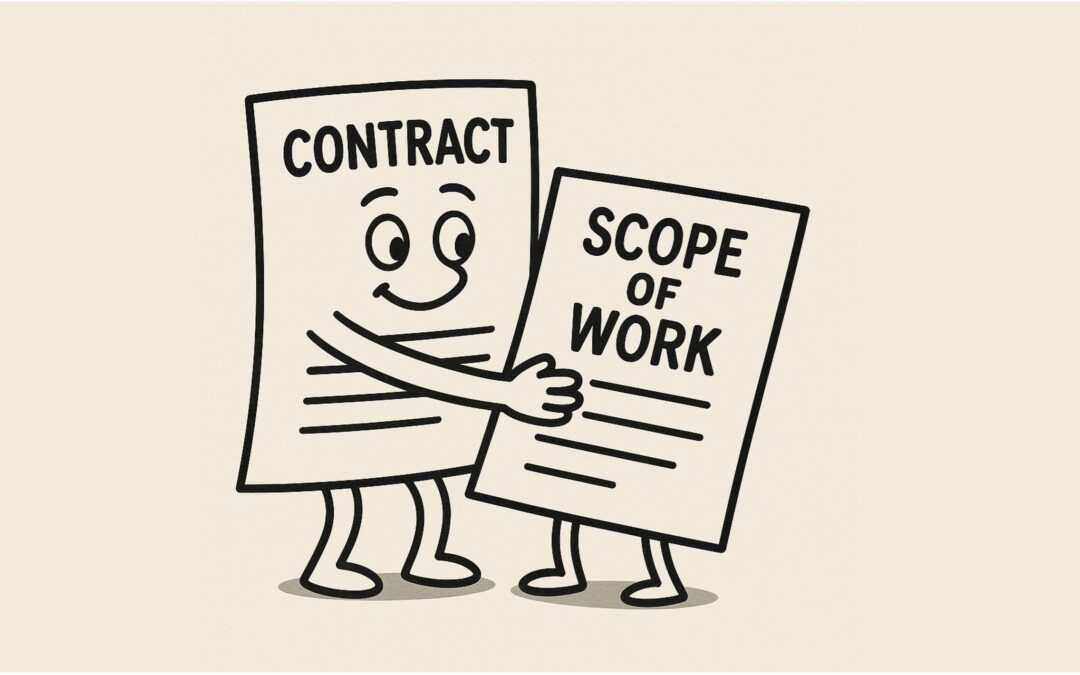After a hard-fought battle, you finally have contract terms and conditions with a supplier. Awesome! But now you want to use that same supplier for a different material or different scope of work, and the idea of renegotiating that contract again is daunting. It’s especially difficult if this scope of work or material has a different lead time, warranty, or logistics/Incoterms. So how do we approach this issue without renegotiating the whole contract again? The quick answer is a wrap agreement. Today’s article talks about when to use a wrap agreement, what one should look like, and things to think about when considering a wrap agreement structure.
Disclaimer: I am not a licensed attorney and cannot give legal advice. Contracts are a legal document and any contract work should include consultation with a licensed attorney with an applicable specialty. All of my thoughts are from being in the procurement and supply chain space for 15 years and leading a 150-person supply chain team at an extremely risk-averse utility business.
What is a Wrap Agreement?
A wrap agreement is also known as an assignment letter, work order or work release, or contract release. It is a legal document that essentially says “We’re going to use these existing terms and conditions for this purchase of goods or services.” It legally ties two documents together – the scope/statement of work and the contract terms that govern a relationship. If you’ve structured your terms and conditions with wrap agreements in mind, it can be a simple thing to use the wrap agreement to adjust the contract exhibits and leave the main contract alone.
Typically a wrap agreement is a couple of pages long (maximum), although it could have a longer scope of work attached to it, and includes the following key items:
- The valid dates of the wrap agreement
- Should the expiration date be different than the core agreement, even outlasting the core agreement?
- Should the start date be upon execution or a separate, fixed date?
- The parties involved
- Which terms and conditions apply to the wrap agreement (especially if the Company has multiple terms with the supplier) and when they were executed
- Any language the wrap agreement replaces
- Order of precedent for the wrap agreement and other documents (preventing a battle of the forms)
- The scope of work/statement of work the wrap agreement is connecting to the terms and conditions
When to Use a Wrap Agreement
The best time to use a wrap agreement is when a company has a strong relationship with a supplier and multiple projects or category purchases from that supplier. Examples would be a construction contractor the company repeatedly uses for factory expansions or other small construction projects (think ARCO Construction), a large manufacturing supplier who sells multiple categories of goods and each category is bid separately due to the competitive market (think General Electric), or an IT software implementation partner who is the go-to implementer for each new software purchase (think Accenture). In each of these examples, negotiating the core terms and conditions (warranty, payment terms, etc.) probably took months, if not years, and involved a lot of legal and supply chain time. Each project or category has its own, clear scope of work, budget, and probably its own set of purchase orders. This is an ideal situation to use a wrap agreement and the supply chain team should strongly consider negotiating the core terms and conditions with a wrap agreement in mind (i.e. keep project-specific items and pricing isolated in the exhibits).
Wrap agreements are faster, easier, and require far fewer inputs on negotiation if done correctly.
When to Negotiate a New Contract
Despite the ease and efficiency of a wrap agreement, there are times to write a new contract instead of wrapping to the previous one. Here are a few examples of when you might negotiate a new contract:
- If there are too many changes to the core terms and conditions (i.e. different warranty, incoterms, AND payment terms), that may be an occasion to negotiate a new contract. Even though the supplier is the same, sometimes a major project has more leverage or a purchasing category is too different from the previous contract.
- If macroeconomic conditions have changed dramatically from when the core contract was different. This might mean things like a global pandemic followed by a major supply chain disruption. Or a recession that causes companies to reevaluate their risk profiles. Or perhaps your government passes a major law that strongly affects either your industry or the suppliers’ industry.
- If one party simply refuses to use the previous terms. In my experience, this is often the supplier and tends to be because of a management, leadership, or ownership change. If this is requested by the supplier, I tend to try to fight it, but sometimes you just don’t have the leverage to do so.
- If the parties change, either moving forward or for just this project. Maybe for this project you have a general contractor working with the major supplier. Or maybe you’re building something along with another company. If the parties to the contract change, you probably need a full new agreement.
Things to Think About
When considering a wrap agreement, there are a few things to consider.
- Are you actually happy with your core terms? They may have been hard fought, yes. But are they actually any good? Have they been working for you, or do they have holes or issues? Is it likely renegotiating would be in your favor?
- How wildly different is this scope from the original scope with the supplier? Is it different enough it necessitates a new contract?
- Do you even need a contract at all? While I am an absolute advocate for contracts, they can be costly to put in place and sometimes companies get a little contract happy, putting them in place for $1000 purchases. Consider if even a purchase order with a note referring to the existing terms and conditions in the event of a dispute is enough.
- As always in procurement, consider your stakeholders. Are there new departments involved in this supplier relationship to be looped in? Is there a research and development initiative that impacts this purchase? Are there implementation partners to consider? Just as we in procurement ask to be considered with projects, we have to consider far-reaching stakeholders in putting contracts in place.
- What does the macroeconomic climate look like now, and how is it different from when the contract was negotiated? Consider major legislation, economics, etc. in addition to your own sales and cost drivers.
If you would like to talk about your wrap agreement structure, let’s chat. If you’d like to get these articles weekly straight to your inbox and never miss one, sign up for my newsletter.
My book, Transform Procurement: The Value of E-auctions is now available in ebook, paperback and even hardcover format: https://www.amazon.com/dp/B0F79T6F25




